|
If you are really
planning to visit Kefallonia and not just
interested in the movie you should probably
save this page because from here on in it is
like a real travel guide.
|
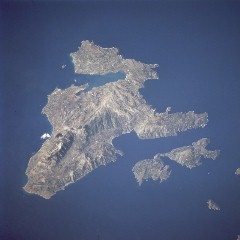
Kefalonia
as seen from space
|
Kefallonia, or
Cephalonia, is the largest of the
Ionians, the string of islands to the
west of mainland Greece and the
Peloponessos, favored by many for
their proximity to Italy and the rest
of Europe and the lack of Meltemi
winds in the summer. It is a green
island, not as wet as Corfu to the
north but rich in vegetation and in
the spring the hills and fields are
alive in a variety of wildflowers.
Like Zakynthos to the south,
Kefallonia is a nesting ground for the
loggerhead turtles which lay their
eggs on the southern beaches in June,
and the Mediterranean Monk Seal, the
rarest of seals and one of the six
most endangered mammals in the world.
The island has 27,000 inhabitants,
some who are fishermen, some who are
farmers and an increasing number who
are now in the tourism trade or will
be soon. The main influences of
Kefallonia, like the rest of the
Ionian islands is Italian since the
Venetians controlled it for almost 300
years. These influences can be found
in the cuisine, architecture, art,
literature and music of the island and
in fact the Kefallonian's were playing
the mandolin at least two centuries
before Corelli picked it up. |
|
|
The two main towns are
Sami
in the northwest part of the
island close to the island of Ithaki, home of
Odysseus and
Argostoli
in the long Gulf of Argostolis
in the south. Because of the island's proximity to
Italy it is flooded with Italian tourists in July
and August. Add to this a large number of package
tourists and you will discover that it is nearly
impossible to find a place to stay during those
two months and the situation is not likely to
improve should the previously mentioned film be a
success. The best advice for traveling there in
late July and August is don't bother. But if you
go there in the off-season you will be rewarded
with one of the most beautiful and fascinating
islands in Greece.
|
|
Argostoli
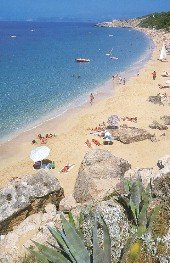 Argostoli is the capital of theisland, a new city which was built
after an earthquake destroyed the old
one in 1953, not the first time the
island has been hit and probably not
the last. The British built an arched
bridge over the Koutavos Lagoon that
connects the city with the rest of the
island. There is a Museum of
Archaeology on Rokou Vergoti Street,
up from the waterfront with a
collection of Mycenaean relics from
the excavations around the island. A
few blocks up is the Historical and
Cultural Museum which contains many
relics of the British and the various
occupiers of the island, as well as
traditional costumes, furniture and
tools. The main harbor of Argostoli is
a lively place with a market on
Saturday and lots of restaurants
including the Taverna Diana, Taverna
Kalafatis and the Anonymos, all
recommended by the kalofages at Lonely
Planet who also recommend Patsousas,
El Greco and Tsivres Brothers for
their island cuisine which is
distinctive due to it's many foreign
influences. They also recommend the
local Robola wine. The main square is
Platia Valianou, lined with tavernas,
cafes and shops and there is a
children's park right next to it.
There are a couple of beaches in the
vicinity of Argostoli called
Makri
Yialos
and
Plati
Yialos
which can be
reached on foot. Both are very nice
beaches but like most town beaches can
be crowded in the summer. There is
plenty of nightlife in Argostoli from
rock and disco to bars and cafes where
you can have a quiet drink and
conversation. Argostoli is the capital of theisland, a new city which was built
after an earthquake destroyed the old
one in 1953, not the first time the
island has been hit and probably not
the last. The British built an arched
bridge over the Koutavos Lagoon that
connects the city with the rest of the
island. There is a Museum of
Archaeology on Rokou Vergoti Street,
up from the waterfront with a
collection of Mycenaean relics from
the excavations around the island. A
few blocks up is the Historical and
Cultural Museum which contains many
relics of the British and the various
occupiers of the island, as well as
traditional costumes, furniture and
tools. The main harbor of Argostoli is
a lively place with a market on
Saturday and lots of restaurants
including the Taverna Diana, Taverna
Kalafatis and the Anonymos, all
recommended by the kalofages at Lonely
Planet who also recommend Patsousas,
El Greco and Tsivres Brothers for
their island cuisine which is
distinctive due to it's many foreign
influences. They also recommend the
local Robola wine. The main square is
Platia Valianou, lined with tavernas,
cafes and shops and there is a
children's park right next to it.
There are a couple of beaches in the
vicinity of Argostoli called
Makri
Yialos
and
Plati
Yialos
which can be
reached on foot. Both are very nice
beaches but like most town beaches can
be crowded in the summer. There is
plenty of nightlife in Argostoli from
rock and disco to bars and cafes where
you can have a quiet drink and
conversation.
|
|
Across from Argostili is the
town of
Lixouri
, the second largest town on Kefallonia which was
built in 1534 and destroyed by the 1953 earthquake
and rebuilt. It is visited mainly because of the
museum and library of the Lakovates and because of
its proximity to several beaches. You can reach
Lixouri by ferry and if you have a car or rent a
motorbike from one of the many shops, you can
explore the rest of the western peninsula or visit
the beach of
Petani
, said to be the best on this part of the
island.
Near Lixouri and of very special interest is the
place called
Katavothres
, which means
pits
, where thousands of tons of sea water pour into
the earth and disappear, passing under the island
and filling the lakes of Melissani and Karavomylos
near Sami.
|
Sami
Sami is the main port of the island
and like Argostoli it was also
destroyed by the earthquake and not
restored to it's previous beauty.
There are Classical and Roman ruins in
the area but the main reason people
come here is to see the nearby
Caves
of
Mellisani
, a sea water lake which was
discovered when the roof collapsed and
the sun revealed the beautiful
turquoise water, and the
Drogarati
Cave
with it's long
corridors and impressive stalactites.
One of it's caverns is said to be
acoustically perfect and in the summer
concerts are held here. Both caves are
within a few miles of Sami and there
are signs posted. They are open all
day and there is an admission charge
of 700 drachma. There are rooms,
hotels and camping in Sami and along
the coast. |
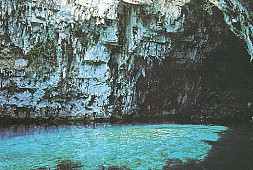
Melisani Caves |
|
|
Fiscardo
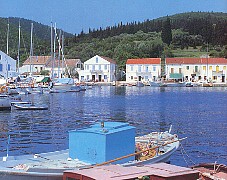 The fishing town of Fiscardo is a favorite of yachters and flotillas and
is also an artist colony and was the
only village not devastated by the
1953 earthquake. Once a quiet village
it has now been 'discovered' and the
lobsters which were so easily found
and caught by anyone with a mask and
snorkel and flippers have now become
rare and only found in the local fish
restaurants. Because it was spared the
destruction of the earthquake many of
the old Venetian buildings still
survive and in the off-season it is a
beautiful and enjoyable place to
visit. But like most of the island,
July and August can be a frustrating
time to be here.(more on that later).
Hotels are a little expensive and
generally unavailable during the
tourist season. Restaurants are
reasonably priced and most are around
the waterfront. Frommers recommends
the Faros, while Lonely Planet
recommends The Captain's Cabin and
Taverna Nicolas, but hint at the near
impossibility of finding a table in
the summer unless you get there
early. The fishing town of Fiscardo is a favorite of yachters and flotillas and
is also an artist colony and was the
only village not devastated by the
1953 earthquake. Once a quiet village
it has now been 'discovered' and the
lobsters which were so easily found
and caught by anyone with a mask and
snorkel and flippers have now become
rare and only found in the local fish
restaurants. Because it was spared the
destruction of the earthquake many of
the old Venetian buildings still
survive and in the off-season it is a
beautiful and enjoyable place to
visit. But like most of the island,
July and August can be a frustrating
time to be here.(more on that later).
Hotels are a little expensive and
generally unavailable during the
tourist season. Restaurants are
reasonably priced and most are around
the waterfront. Frommers recommends
the Faros, while Lonely Planet
recommends The Captain's Cabin and
Taverna Nicolas, but hint at the near
impossibility of finding a table in
the summer unless you get there
early.
|
|
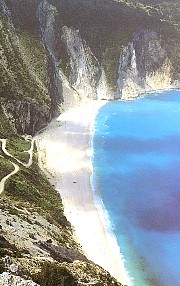 The west coast ofthe island is known for having the
best beaches as well as the most
beautiful landscape. If you start at
Fiscardo and travel south you will
come to the village of
Assos
with it's port, one
of the most picturesque in Greece,
pastel colored houses and it's
Venetian fortress. Nearby the beach
of
Myrtos(photo) is one of the most
spectacular beaches in Greece with
tall cliffs and white sand and the
color sea that most travelers are
seeking when they come to the Greek
islands. If you continue along the
coast there are many more small coves
and beaches but most of them are
accessible only by boat.
The west coast ofthe island is known for having the
best beaches as well as the most
beautiful landscape. If you start at
Fiscardo and travel south you will
come to the village of
Assos
with it's port, one
of the most picturesque in Greece,
pastel colored houses and it's
Venetian fortress. Nearby the beach
of
Myrtos(photo) is one of the most
spectacular beaches in Greece with
tall cliffs and white sand and the
color sea that most travelers are
seeking when they come to the Greek
islands. If you continue along the
coast there are many more small coves
and beaches but most of them are
accessible only by boat.
Around
Kefalonia
According to my pal David Willett, formerly of Lonely Planet, in the village of
Markopoulo
a miracle occurs
every year. On the 15th of August, the
saint day of the Panagia (Virgin
Mary), and the second holiest day in
Greece, the village church becomes
infested with small
snakes with crosses on their heads.
The snakes are non-poisonous and are
said to bring good luck to the
village. As mysteriously as they have
come, they disappear until next year,
same time and same place. But according to a woman who grew up in Kefalonia this is a little misleading "The snakes are about 5 to 10 and they come out from 6th of August to the 15th on the rocks and the villagers collect them.This phenomenon not only happens in Markopoulo but also in an other village up the mountain called Arginia."
|
|
The ruins of
Kastro
above the village of
Peratata
, 9 km south-east of Argostoli was the capital of
the island in the middle ages and has a 13th
Century Castle of Saint George. Near Perarata
is
Lourdata
beach which offers horseback
riding. There is also a beautiful two and a half
hour nature walk. You can get a trail map from the
EOT (Greek National Tourist Office) in
Argostoli.
Metaxata
is where Lord Byron stayed for
four months before going to Missolonghi to fight
in the Greek War of Independence and become a
martyr.It was here in Metaxata that he wrote the
poem Don Juan.
Skala
on the southern tip of the
island is a tourist resort as is
Poros.
But there could be more to Poros than meets the eye. The discovery of a large grave has convinced a few people that this was the grave of Odysseus and that Poros, the site of an ancient city much larger than anything found on the neighboring island of Ithaki, is perhaps the city that the hero of Homer's Odyssey was returning to. The grave was full of gold jewelry, which generally means it was the final resting place of a king, (or kings). These can be seen in
in the Archaeological Museum in Argostoli. Among them is a gold brooch, described by a disguised Odysseus to his wife Penelope to assure her that he had seen her husband (himself) on the island of Crete. Odysseus' descriptions of his beloved Ithaki bear a striking resemblance to Poros with the Cave of the Nymphs being a days walk (you can drive now) and the views of the tree-clad Mount Neriton which might be Mount Aenos just above Poros. So is Poros the ancient Ithaki? If anyone knows for sure they have
not said so yet. Maybe the best thing to do is read the Odyssey and then visit Ithaki and Kefalonia and decide for yourself.
|
|
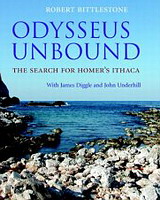 Odysseus Unbound by Robert Bittlestone Odysseus Unbound by Robert Bittlestone
Where is the Ithaca described in such detail in Homer's Odyssey? The mystery has baffled scholars for over two millennia, particularly because Homer's descriptions bear little resemblance to the modern island called Ithaki. This highly illustrated book tells the extraordinary story of the exciting recent discovery of the true location of Homer's Ithaca by following a detective trail of literary, geological and archaeological clues. We can now identify all the places on the island that are mentioned in
the epic – even the site of Odysseus' Palace itself. The pages of the Odyssey come alive as we follow its events through a landscape that opens up before our eyes via glorious colour photographs and 3D satellite images. Over a century after Schliemann's discovery of Troy, this breakthrough will revolutionise our understanding of Homer's texts and of our cultural ancestors in Bronze Age Greece. You can order this book from Greece In Print
 You can find many hotels in Kefalonia by location, price, whether or not it has a swimming pool or is on the beach, and see photos, maps and customer reviews by using this link to booking.com.
Excellent
prices and many hotels
you can book and then cancel with no cancellation fee. For those who want to book without using a travel agency this is the best way to do it. You can find many hotels in Kefalonia by location, price, whether or not it has a swimming pool or is on the beach, and see photos, maps and customer reviews by using this link to booking.com.
Excellent
prices and many hotels
you can book and then cancel with no cancellation fee. For those who want to book without using a travel agency this is the best way to do it.
|
More
Kefalonia Stuff:
|
|
|
|